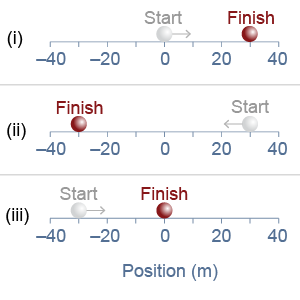|
Position describes a location in space relative to an origin. Coordinates describe a position in three dimensions, using a set of three numbers (such as x, y, and z) and a set of distance units (such as meters). An object’s position is a vector: a quantity with both a value (magnitude) and direction. Displacement is also a vector: It describes a change in position. Vectors can be added graphically (with the “head-to-tail” rule) or numerically—by separately adding their x-, y-, and z-components. 
|
|
position, origin, displacement, vector, magnitude, scalar, coordinates
|
Review problems and questions |
|
- Classify each of the following as a distance or a displacement:
- Jodie sat 20 ft from the teacher’s desk.
- Maurice drove his car a quarter-mile north of the train station.
- Yasmin hiked 6 km through the San Gabriel Wilderness.
- Ali kicked the ball 40 yards away.


|
Answer: - Distance: No direction is given.
- Displacement: A direction (“north”) is specified
- Distance: No direction is given.
- Distance: No direction is given.

|
- In one dimension, positions and displacements can be positive, negative, or zero.
- What is the difference between a negative position and a negative displacement?
- Is it possible to undergo a negative displacement and end up at a positive position?


|
Answer: - A negative position is any location to the left of the origin. A negative displacement is any change in position that involves moving in the negative direction.
- Yes, it is possible to undergo a negative displacement and end up at a positive location. For example, an object at position +8.0 m can undergo a displacement d = −2.0 m and end up at the position +6.0 m.

- A dog initially located at position (3, 3) m in the x–y plane undergoes the following displacements: d1 = (2, 1) m, d2 = (−4, −2) m, and d3 = (3, −2) m.
- What is the total displacement of the dog?
- What is the final position of the dog with respect to the origin?


|
Answer: - The total displacement is (+1, −3) m.
- The final position with respect to the origin is (+4, 0) m.

|
- A plane starts at airport A and undergoes the following displacements before landing at airport B: d1 = (+14 km, +32 km) and d2 = (+18 km, −11 km). Next, the plane returns directly to airport A.
- What displacement does the plane undergo during the return trip?
- What is the total displacement of the plane during the entire round trip?


|
Answer: - The displacement from airport B back to A is (−32 km, −21 km).
- The total displacement is zero.

|

- Step i: A ball rolls from the origin on a one-dimensional coordinate axis and stops at (x = 30 m).
Step ii: It next rolls from (x = 30 m) to (x = −30 m).
Step iii: Finally, it rolls from (x = −30 m) to (x = 0 m). - What is the ball’s displacement during Step i?
- What is the ball’s displacement during Step ii?
- What is the ball’s displacement during Step iii?
- What is the total of the three displacements?
- Generalize about the displacement of any round trip (one that begins and ends at the same position).


|
Answer: - Displacement = +30 m because the ball moves 30 m in the +x-direction.
- Displacement = −60 m because the ball moves 60 m in the −x-direction.
- Displacement = +30 m because the ball moves 30 m in the +x-direction a second time.
- The displacements add up to zero since (+30 m) + (−60 m) + (+30 m) = 0 m.
- The total displacement is zero for any round trip because your final and original coordinates are identical.

|
Take a Quiz |
|
| |
|

